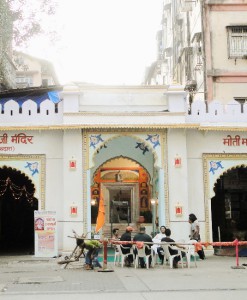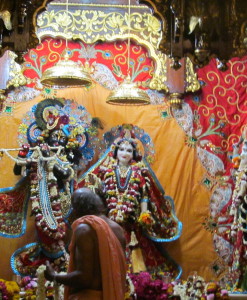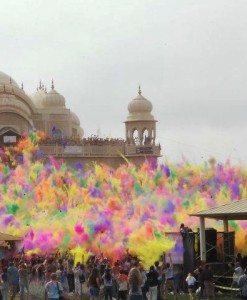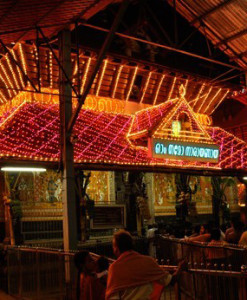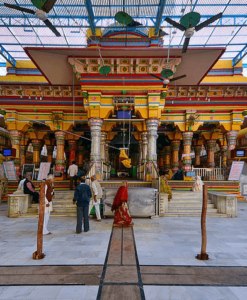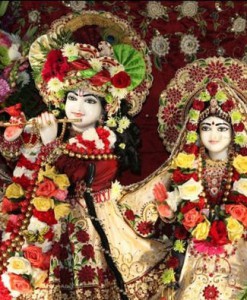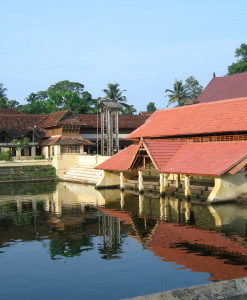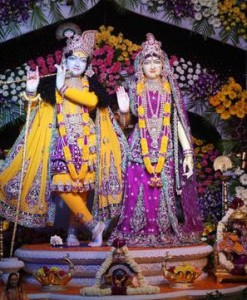No products in the cart.
Chief shrine of RadhaVallabh sect, old RadhaVallabh Temple at Vrindavan, though now abandoned but protected monument is in itself a handsome building and its spatial architectural interest is the last example of the early Eclectic style. It was constructed by Sundardas Bhatnagar, a disciple of Shri Vanchandraji, son of Hit Harivansh Mahaprabhu, founder of the RadhaVallabh sect. Wilson noted an inscription over the gateway of this temple, now no longer extant, that it was in 1585, when this temple was constructed. Abdul Rahim Khankhana, the Dewan at Akbar’s court, in whose employment Sundardas Bhatnagar of Deoband was, not only got Royal permission to use red sandstone for temple construction, which was till then used only for construction of imperial buildings, royal palaces and forts, but also monetary grant for this temple from Akbar. Descendants of Sunderdas Bhatnagar at Deoband still have these documents with them. It is said that Raja Mansingh first decided to contract this temple. But on hearing a legend that whosoever will construct this temple will die within a year, he backed out. Actually Sundardas died within a year, after he with his personal treasure as well as help from Abdul Rahim Khankhana and Akbar constructed it.
Radhavallabh Mandir , Vrindavan;
Founder of the Shri RadhaVallabh sect was His Divine Grace was Goswami Hit Harivansh Mahaprabhu. His father, Shri Vyas Mishra, was a Gaur Brahman of Devaband in Saharanpur district of Utter Pradesh, who was in service of the Moghul Emperor Humayun,
According to Tarikh-I-Deoband (Syed Mehbub Rizvi, IImi-Marqaz, Deoband), On one occasion while Shri Vyas Mishra was accompanying Emperor on his march from Agra, his wife Tara, gave birth to a son at the Royal Army Camp at Bad, near Mathura on 11th day (Ekadashi) Monday of in the Samvat 1530, In grateful recognition of their answered prayers, the parents named the child after the God they had invoked, and called him Hari Vana, i.e. Hari’s issue. The Emperor celebrated with pomp and splendor heralding the incarnation of sacred flute of the Lord.
Gulbadan Begum, sister of the Emperor in her book “Humayaunnama” (preserved in Gulistan Library at Tehran, capital of Iran) and Zauhar Aftabchi in his book “Tazkirat-ul-Wakiat” had described in detail that how for ten days there were festivities celebrated, profuse Lightings’ fireworks, feasts, etc., continued during this period. The Emperor, his Queen Mariam Makani, his sister Gulbadan Begum, prominent courtiers Beiram Khan, Tardi Beg, Yaqoob Beg, Zauhar Aftabchi, Dost Baba, Khoja Amber, etc. sent gifts and greetings to Pt. Vyas Mishra, Alme were given to beggarsand gifts to courtesans. One part of the Royal caravan was staying at Jamalpur Serai, three ‘Kos’ away from Bad on Agra-Delhi Road, where also festivities in the honor of Hit Harivansh Mahaprabhu were celebrated on large scale for ten days supervised and managed by Abdul Majeed, the then Dewan of Mathura at the Royal expense. Bu the order of Emperor, all the inmates of Royal caravan abstained from alcoholic drinks and non-vegetarian food during this period.
To mark the serenity of the occasion, the Emperor ordered that in future Royal Armies should not camp at Baad; instead Farah was declared camping ground.
Hit Harivansh Mahaprabhu passed his childhood at Deoband. Once playing with his playmates the ball fell in a deep wall. Mahaprabhu jumped into the well and came out with a Shri Vigraha (Lord’s idol). This well still exists and Idol installed in the ancestral palace, at Deoband widely known as Shri Radha Navarangilalaji. Here at Deoband, once whiles asleep, Shri Radha gave Her Holy ‘darshan’ (audience) in dream to Hit Harivansh Mahaprabhu and blessed Him with ‘Mantra’ (Holy couplet) under a people tree. This tree still exists at Deoband in the precincts of temple.
When he had grown up, his Yagyapaveet (Sacred Thread) ceremony was performed, and later he was married to RukminiJi, determined to abandon the world and lead the life of an ascetic. At that time he was 32 with this resolution he set out on the road to Vrindavan and had reached Charthawal, near Muzaffarnagar. Here at night he received in a vision while asleep at night Divine command from Shri Radha, that “you will meet a Brahman who had got My Icon. Take this Icon to Vrindavan to worship as also to marry his two daughters.”She (Shri Radha) gave a similar dream to Atmadeva Brahman. Next morning Hit Harivansh Mahaprabhu was married at a simple but solemn ceremony and the icon, named RadhaVallabh gifted to him.
This temple represents a living dialogue between Hindu and Islamic elements in Mediaeval Architecture. The walls having a thickness of 10 feet and are pierced in two stages, the upper stage being a regular Triforium to which access was obtained by an internal staircase. This Triforium is a reproduction of Mohammedan’s designs, while the work, both upper and below, it is purely Hindu Architecture. In fact this temple is the last temple in the neighborhood in which a naive was built at all. In the modern style, it is so completely obsolete, that its distinctive name is even forgotten by some architects.
This temple is characterized by its architectural accent on harmony of lines and balanced massing. It reflects constructional unity more than richness of ornamentation. If in any art it were possible to revive the dead, or if it were in human nature ever to return absolutely upon the past, this style of RadhaVallabh temple would seem to be the one for our architects to copy.
By Road: This temple is situated at Gotam Nagar, Vrindavan (UP). This place is 12.3 km far from Chatikara and easily connected from Agra and Delhi.From Delhi, it is approx 150 km distance on NH2. At Chatikara, head south-east on NH2 turn toward Bhaktivedanta Swami Marg and turn left and just after straight road, on your left you will find Radha Ballabh temple. Tourists or visitors can take local buses, taxis, rickshaw and or cheapest shared autos for visiting Mathura and Vrindavan. Rickshaw ride will cost Rs 10 from Chatikara, Vrindavan.
By Rail: It has its own Railway Station named as Vrindavan Railway Station which is connected to almost all the major cities of Uttar Pradesh like Delhi, Jaipur, Nagpur, Pune and Bangalore.
By Air: The nearest International Airport from Vrindavan is Indira Gandhi International Airport, New Delhi, about 144 Kms away and is roughly four hour drive from Vrindavan city. Frequent Flights to various national and international destinations such as Hyderabad, Ahmedabad, Aurangabad, Bangalore, Bhopal, Chennai, and Coimbatore take off from here.
There is no entry fee to this temple and it remains open throughout the year. This temple remains open everyday between 5:00 am to 09:00 pm and timings of Darshans are as follows:
The main festival of Radha Ballabh temple is performed for eleven day heralding the birth anniversary of Shree Hit Harivansh Chandra Mahaprabhu. Devotees perform dance and songs in memory of great lord and his follower. Shri Radha and Lord Krishna are carried on decorated chariot along with musical band and fabulous devotional songs performed by devotees. This rath-yatra, starts from temple, culminates at Raas Mandal, followed along side at main street. On the tenth day of this amazing festival, the deity at Radha Vallabh Temple is adorned and decorated in royal red cloths.
Devotees keep awake whole night and celebrate this occasion. Another grand festival is Shri Radha Ashtami festival which is performed nine-day long heralding the birthday of Shree Radha. In this festival also, chariot is decorated with beautiful flowers and lights. Various delicious and Mata Rani’s favorite food like gujhias, ladoos, panjiree, rajbhog, rice and many others is prepared. Other annual festivals like: Janmashtmi, Holi, Deepawali, Annakoot, Sanjhi and many others are celebrated with great enthusiasm and devotion.



